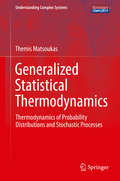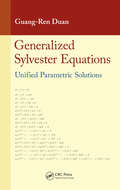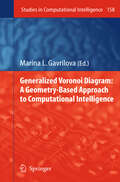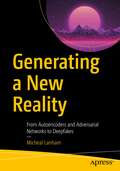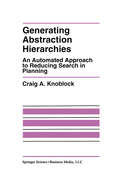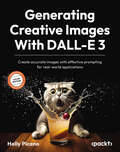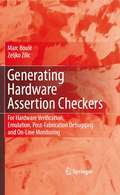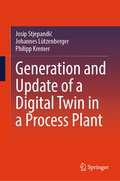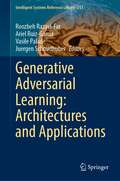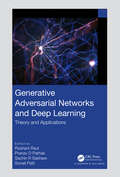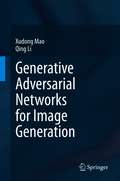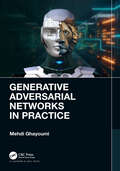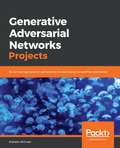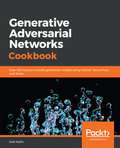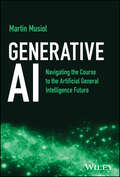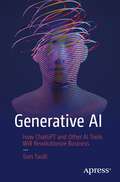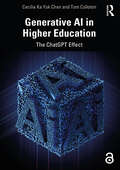- Table View
- List View
Generalized Statistical Thermodynamics: Thermodynamics of Probability Distributions and Stochastic Processes (Understanding Complex Systems)
by Themis MatsoukasThis book gives the definitive mathematical answer to what thermodynamics really is: a variational calculus applied to probability distributions. Extending Gibbs's notion of ensemble, the Author imagines the ensemble of all possible probability distributions and assigns probabilities to them by selection rules that are fairly general. The calculus of the most probable distribution in the ensemble produces the entire network of mathematical relationships we recognize as thermodynamics. The first part of the book develops the theory for discrete and continuous distributions while the second part applies this thermodynamic calculus to problems in population balance theory and shows how the emergence of a giant component in aggregation, and the shattering transition in fragmentation may be treated as formal phase transitions. While the book is intended as a research monograph, the material is self-contained and the style sufficiently tutorial to be accessible for self-paced study by an advanced graduate student in such fields as physics, chemistry, and engineering.
Generalized Sylvester Equations: Unified Parametric Solutions
by Guang-Ren DuanProvides One Unified Formula That Gives Solutions to Several Types of GSEsGeneralized Sylvester equations (GSEs) are applied in many fields, including applied mathematics, systems and control, and signal processing. Generalized Sylvester Equations: Unified Parametric Solutions presents a unified parametric approach for solving various types of GSEs
Generalized Voronoi Diagram: A Geometry-Based Approach to Computational Intelligence (Studies in Computational Intelligence #158)
by Marina L. GavrilovaThe year 2008 is a memorial year for Georgiy Vorono (1868-1908), with a number of events in the scientific community commemorating his tremendous contribution to the area of mathematics, especially number theory, through conferences and scientific gatherings in his honor. A notable event taking place in September 2008 a joint c- ference: the 5th Annual International Symposium on Voronoi Diagrams (ISVD) and the 4th International Conference on Analytic Number Theory and Spatial Tessel- tions held in Kyiv, Georgiy Vorono ’s native land. The main ideas expressed by G. Vorono ’s through his fundamental works have influenced and shaped the key dev- opments in computation geometry, image recognition, artificial intelligence, robotics, computational science, navigation and obstacle avoidance, geographical information systems, molecular modeling, astrology, physics, quantum computing, chemical en- neering, material sciences, terrain modeling, biometrics and other domains. This book is intended to provide the reader with in-depth overview and analysis of the fundamental methods and techniques developed following G. Voronoi ideas, in the context of the vast and increasingly growing area of computational intelligence. It represents the collection of state-of-the art research methods merging the bridges between two areas: geometric computing through Voronoi diagrams and intelligent computation techniques, pushing the limits of current knowledge in the area, impr- ing on previous solutions, merging sciences together, and inventing new ways of approaching difficult applied problems.
Generating a New Reality: From Autoencoders and Adversarial Networks to Deepfakes
by Micheal LanhamThe emergence of artificial intelligence (AI) has brought us to the precipice of a new age where we struggle to understand what is real, from advanced CGI in movies to even faking the news. AI that was developed to understand our reality is now being used to create its own reality. In this book we look at the many AI techniques capable of generating new realities. We start with the basics of deep learning. Then we move on to autoencoders and generative adversarial networks (GANs). We explore variations of GAN to generate content. The book ends with an in-depth look at the most popular generator projects.By the end of this book you will understand the AI techniques used to generate different forms of content. You will be able to use these techniques for your own amusement or professional career to both impress and educate others around you and give you the ability to transform your own reality into something new.What You Will LearnKnow the fundamentals of content generation from autoencoders to generative adversarial networks (GANs)Explore variations of GANUnderstand the basics of other forms of content generationUse advanced projects such as Faceswap, deepfakes, DeOldify, and StyleGAN2Who This Book Is ForMachine learning developers and AI enthusiasts who want to understand AI content generation techniques
Generating Abstraction Hierarchies: An Automated Approach to Reducing Search in Planning (The Springer International Series in Engineering and Computer Science #214)
by Craig A. KnoblockGenerating Abstraction Hierarchies presents a completely automated approach to generating abstractions for problem solving. The abstractions are generated using a tractable, domain-independent algorithm whose only inputs are the definition of a problem space and the problem to be solved and whose output is an abstraction hierarchy that is tailored to the particular problem. The algorithm generates abstraction hierarchies that satisfy the `ordered monotonicity' property, which guarantees that the structure of an abstract solution is not changed in the process of refining it. An abstraction hierarchy with this property allows a problem to be decomposed such that the solution in an abstract space can be held invariant while the remaining parts of a problem are solved. The algorithm for generating abstractions is implemented in a system called ALPINE, which generates abstractions for a hierarchical version of the PRODIGY problem solver. Generating Abstraction Hierarchies formally defines this hierarchical problem solving method, shows that under certain assumptions this method can reduce the size of a search space from exponential to linear in the solution size, and describes the implementation of this method in PRODIGY. The abstractions generated by ALPINE are tested in multiple domains on large problem sets and are shown to produce shorter solutions with significantly less search than problem solving without using abstraction. Generating Abstraction Hierarchies will be of interest to researchers in machine learning, planning and problem reformation.
Generating Analog IC Layouts with LAYGEN II (SpringerBriefs in Applied Sciences and Technology)
by Ricardo M. Martins Nuno C. Lourenço Nuno C.G. HortaThis book presents an innovative methodology for the automatic generation of analog integrated circuits (ICs) layout, based on template descriptions and on evolutionary computational techniques. A design automation tool, LAYGEN II was implemented to validate the proposed approach giving special emphasis to reusability of expert design knowledge and to efficiency on retargeting operations.
Generating Creative Images With DALL-E 3: Create accurate images with effective prompting for real-world applications
by Holly PicanoLearn to craft fine art prints, NFTs, and captivating covers for books and magazines with Dall-E 3 and ChatGPTKey FeaturesExplore Dall-E 3's diverse practical applications across art, design, education, and beyondMaster AI-generated art creation through step-by-step tutorials, ranging from basic to advanced projectsEnhance your prompt crafting skills with the exclusive prompt cheat sheetPurchase of the print or Kindle book includes a free PDF eBookBook DescriptionUnveil the extraordinary capabilities of the groundbreaking AI model, DALL-E 3, as it transforms text prompts into accurate images. This book addresses the challenge of creating meaningful images by writing prompts, guiding you step by step through creating stunning visual art regardless of your skill level. Prepare to delve deep into the inner workings of DALL-E 3's architecture and training process. With clear explanations, practical tutorials, and real-world examples that can be easily applied, you’ll unlock secrets to creating awe-inspiring AI-generated art, from fine art prints to digital designs. This book provides comprehensive insights into various lens options, camera angles, lighting techniques, and art movements, helping you integrate AI capabilities with your artistic skills. You’ll also learn to create NFTs that can be monetized and gain invaluable insights into designing compelling covers, all within the ethical boundaries of AI-generated art. And with the invaluable prompt cheat sheet by your side, you’ll hone your skills in formulating captivating prompts for diverse purposes. By the end of this book, you’ll have learned how to produce generative AI art at a rapid pace and relatively low cost and push the boundaries of imagination with DALL-E 3.What you will learnMaster DALL-E 3's architecture and training methodsCreate fine prints and other AI-generated art with precisionSeamlessly blend AI with traditional artistryAddress ethical dilemmas in AI artExplore the future of digital creativityImplement practical optimization techniques for your artistic endeavorsWho this book is forWhether you’re an artist looking to integrate AI into your work, a designer seeking new creative horizons, a tech enthusiast intrigued by the intersection of art and artificial intelligence, an educator in the fields of art and technology, or a curious individual venturing into AI-generated art, this book is for you. For anyone interested in the innovative fusion of creativity and technology, the DALL-E 3 Guide to AI Artistry offers invaluable insights and practical skills that you can apply right away.
Generating Hardware Assertion Checkers: For Hardware Verification, Emulation, Post-Fabrication Debugging and On-Line Monitoring
by Marc Boulé Zeljko ZilicAssertion-based design is a powerful new paradigm that is facilitating quality improvement in electronic design. Assertions are statements used to describe properties of the design (I.e., design intent), that can be included to actively check correctness throughout the design cycle and even the lifecycle of the product. With the appearance of two new languages, PSL and SVA, assertions have already started to improve verification quality and productivity. This is the first book that presents an “under-the-hood” view of generating assertion checkers, and as such provides a unique and consistent perspective on employing assertions in major areas, such as: specification, verification, debugging, on-line monitoring and design quality improvement.
Generating Plans from Proofs (Synthesis Lectures on Data Management)
by Michael Benedikt Julien Leblay Balder ten Cate Efthymia TsamouraQuery reformulation refers to a process of translating a source query—a request for information in some high-level logic-based language—into a target plan that abides by certain interface restrictions. Many practical problems in data management can be seen as instances of the reformulation problem. For example, the problem of translating an SQL query written over a set of base tables into another query written over a set of views; the problem of implementing a query via translating to a program calling a set of database APIs; the problem of implementing a query using a collection of web services. In this book we approach query reformulation in a very general setting that encompasses all the problems above, by relating it to a line of research within mathematical logic. For many decades logicians have looked at the problem of converting "implicit definitions" into "explicit definitions," using an approach known as interpolation. We will review the theory of interpolation, and explain its close connection with query reformulation. We will give a detailed look at how the interpolation-based approach is used to generate translations between logic-based queries over different vocabularies, and also how it can be used to go from logic-based queries to programs.
Generation and Update of a Digital Twin in a Process Plant
by Josip Stjepandić Johannes Lützenberger Philipp KremerThis book covers the most important subjects of digital twin in a process plant, including foundations, methods, achievements, and applications in a brownfield environment. Besides offering a variety of applications and procedural variants from research and industrial practice, this book also provides a comprehensive insight into holistic plant planning. It also discusses the challenges that currently exist in different application areas. This book would be of interest to industry professionals and researchers in industrial and manufacturing engineering.
Generative Adversarial Learning: Architectures and Applications (Intelligent Systems Reference Library #217)
by Vasile Palade Roozbeh Razavi-Far Ariel Ruiz-Garcia Juergen SchmidhuberThis book provides a collection of recent research works addressing theoretical issues on improving the learning process and the generalization of GANs as well as state-of-the-art applications of GANs to various domains of real life. Adversarial learning fascinates the attention of machine learning communities across the world in recent years. Generative adversarial networks (GANs), as the main method of adversarial learning, achieve great success and popularity by exploiting a minimax learning concept, in which two networks compete with each other during the learning process. Their key capability is to generate new data and replicate available data distributions, which are needed in many practical applications, particularly in computer vision and signal processing. The book is intended for academics, practitioners, and research students in artificial intelligence looking to stay up to date with the latest advancements on GANs’ theoretical developments and their applications.
Generative Adversarial Networks and Deep Learning: Theory and Applications
by Roshani RautThis book explores how to use generative adversarial networks in a variety of applications and emphasises their substantial advancements over traditional generative models. This book's major goal is to concentrate on cutting-edge research in deep learning and generative adversarial networks, which includes creating new tools and methods for processing text, images, and audio. A Generative Adversarial Network (GAN) is a class of machine learning framework and is the next emerging network in deep learning applications. Generative Adversarial Networks(GANs) have the feasibility to build improved models, as they can generate the sample data as per application requirements. There are various applications of GAN in science and technology, including computer vision, security, multimedia and advertisements, image generation, image translation,text-to-images synthesis, video synthesis, generating high-resolution images, drug discovery, etc. Features: Presents a comprehensive guide on how to use GAN for images and videos. Includes case studies of Underwater Image Enhancement Using Generative Adversarial Network, Intrusion detection using GAN Highlights the inclusion of gaming effects using deep learning methods Examines the significant technological advancements in GAN and its real-world application. Discusses as GAN challenges and optimal solutions The book addresses scientific aspects for a wider audience such as junior and senior engineering, undergraduate and postgraduate students, researchers, and anyone interested in the trends development and opportunities in GAN and Deep Learning. The material in the book can serve as a reference in libraries, accreditation agencies, government agencies, and especially the academic institution of higher education intending to launch or reform their engineering curriculum
Generative Adversarial Networks and Deep Learning: Theory and Applications
by Roshani Raut Pranav D Pathak Sachin R Sakhare Sonali PatilThis book explores how to use generative adversarial networks in a variety of applications and emphasises their substantial advancements over traditional generative models. This book's major goal is to concentrate on cutting-edge research in deep learning and generative adversarial networks, which includes creating new tools and methods for processing text, images, and audio. A Generative Adversarial Network (GAN) is a class of machine learning framework and is the next emerging network in deep learning applications. Generative Adversarial Networks(GANs) have the feasibility to build improved models, as they can generate the sample data as per application requirements. There are various applications of GAN in science and technology, including computer vision, security, multimedia and advertisements, image generation, image translation,text-to-images synthesis, video synthesis, generating high-resolution images, drug discovery, etc. Features: Presents a comprehensive guide on how to use GAN for images and videos. Includes case studies of Underwater Image Enhancement Using Generative Adversarial Network, Intrusion detection using GAN Highlights the inclusion of gaming effects using deep learning methods Examines the significant technological advancements in GAN and its real-world application. Discusses as GAN challenges and optimal solutions The book addresses scientific aspects for a wider audience such as junior and senior engineering, undergraduate and postgraduate students, researchers, and anyone interested in the trends development and opportunities in GAN and Deep Learning. The material in the book can serve as a reference in libraries, accreditation agencies, government agencies, and especially the academic institution of higher education intending to launch or reform their engineering curriculum
Generative Adversarial Networks for Image Generation
by Xudong Mao Qing LiGenerative adversarial networks (GANs) were introduced by Ian Goodfellow and his co-authors including Yoshua Bengio in 2014, and were to referred by Yann Lecun (Facebook’s AI research director) as “the most interesting idea in the last 10 years in ML.” GANs’ potential is huge, because they can learn to mimic any distribution of data, which means they can be taught to create worlds similar to our own in any domain: images, music, speech, prose. They are robot artists in a sense, and their output is remarkable – poignant even. In 2018, Christie’s sold a portrait that had been generated by a GAN for $432,000. Although image generation has been challenging, GAN image generation has proved to be very successful and impressive. However, there are two remaining challenges for GAN image generation: the quality of the generated image and the training stability. This book first provides an overview of GANs, and then discusses the task of image generation and the details of GAN image generation. It also investigates a number of approaches to address the two remaining challenges for GAN image generation. Additionally, it explores three promising applications of GANs, including image-to-image translation, unsupervised domain adaptation and GANs for security. This book appeals to students and researchers who are interested in GANs, image generation and general machine learning and computer vision.
Generative Adversarial Networks in Practice
by Mehdi GhayoumiThis book is an all-inclusive resource that provides a solid foundation on Generative Adversarial Networks (GAN) methodologies, their application to real-world projects, and their underlying mathematical and theoretical concepts. Key Features: • Guides you through the complex world of GANs, demystifying their intricacies • Accompanies your learning journey with real-world examples and practical applications • Navigates the theory behind GANs, presenting it in an accessible and comprehensive way • Simplifies the implementation of GANs using popular deep learning platforms • Introduces various GAN architectures, giving readers a broad view of their applications • Nurture your knowledge of AI with our comprehensive yet accessible content • Practice your skills with numerous case studies and coding examples • Reviews advanced GANs, such as DCGAN, cGAN, and CycleGAN, with clear explanations and practical examples • Adapts to both beginners and experienced practitioners, with content organized to cater to varying levels of familiarity with GANs • Connects the dots between GAN theory and practice, providing a well-rounded understanding of the subject • Takes you through GAN applications across different data types, highlighting their versatility • Inspires the reader to explore beyond this book, fostering an environment conducive to independent learning and research • Closes the gap between complex GAN methodologies and their practical implementation, allowing readers to directly apply their knowledge • Empowers you with the skills and knowledge needed to confidently use GANs in your projects Prepare to deep dive into the captivating realm of GANs and experience the power of AI like never before with Generative Adversarial Networks (GANs) in Practice. This book brings together the theory and practical aspects of GANs in a cohesive and accessible manner, making it an essential resource for both beginners and experienced practitioners.
Generative Adversarial Networks in Practice
by Mehdi GhayoumiThis book is an all-inclusive resource that provides a solid foundation on Generative Adversarial Networks (GAN) methodologies, their application to real-world projects, and their underlying mathematical and theoretical concepts. Key Features: • Guides you through the complex world of GANs, demystifying their intricacies • Accompanies your learning journey with real-world examples and practical applications • Navigates the theory behind GANs, presenting it in an accessible and comprehensive way • Simplifies the implementation of GANs using popular deep learning platforms • Introduces various GAN architectures, giving readers a broad view of their applications • Nurture your knowledge of AI with our comprehensive yet accessible content • Practice your skills with numerous case studies and coding examples • Reviews advanced GANs, such as DCGAN, cGAN, and CycleGAN, with clear explanations and practical examples • Adapts to both beginners and experienced practitioners, with content organized to cater to varying levels of familiarity with GANs • Connects the dots between GAN theory and practice, providing a well-rounded understanding of the subject • Takes you through GAN applications across different data types, highlighting their versatility • Inspires the reader to explore beyond this book, fostering an environment conducive to independent learning and research • Closes the gap between complex GAN methodologies and their practical implementation, allowing readers to directly apply their knowledge • Empowers you with the skills and knowledge needed to confidently use GANs in your projects Prepare to deep dive into the captivating realm of GANs and experience the power of AI like never before with Generative Adversarial Networks (GANs) in Practice. This book brings together the theory and practical aspects of GANs in a cohesive and accessible manner, making it an essential resource for both beginners and experienced practitioners.
Generative Adversarial Networks Projects: Build Next-generation Generative Models Using Tensorflow And Keras
by Kailash AhirwarIn this book, we will use different complexities of datasets in order to build end-to-end projects. With every chapter, the level of complexity and operations will become advanced. It consists of 8 full-fledged projects covering approaches such as 3D-GAN, Age-cGAN, DCGAN, SRGAN, StackGAN, and CycleGAN with real-world use cases.
Generative Adversial Networks Cookbook: Over 100 Recipes To Build Generative Models Using Python, Tensorflow, And Keras
by Josh KalinGenerative Adversarial Networks have opened up many new possibilities in the machine learning domain. This book is all you need to implement different types of GANs using TensorFlow and Keras, in order to provide optimized and efficient deep learning solutions.
Generative AI: Navigating the Course to the Artificial General Intelligence Future
by Martin MusiolAn engaging and essential discussion of generative artificial intelligence In Generative AI: Navigating the Course to the Artificial General Intelligence Future, celebrated author Martin Musiol—founder and CEO of generativeAI.net and GenAI Lead for Europe at Infosys—delivers an incisive and one-of-a-kind discussion of the current capabilities, future potential, and inner workings of generative artificial intelligence. In the book, you'll explore the short but eventful history of generative artificial intelligence, what it's achieved so far, and how it's likely to evolve in the future. You'll also get a peek at how emerging technologies are converging to create exciting new possibilities in the GenAI space. Musiol analyzes complex and foundational topics in generative AI, breaking them down into straightforward and easy-to-understand pieces. You'll also find: Bold predictions about the future emergence of Artificial General Intelligence via the merging of current AI models Fascinating explorations of the ethical implications of AI, its potential downsides, and the possible rewards Insightful commentary on Autonomous AI Agents and how AI assistants will become integral to daily life in professional and private contexts Perfect for anyone interested in the intersection of ethics, technology, business, and society—and for entrepreneurs looking to take advantage of this tech revolution—Generative AI offers an intuitive, comprehensive discussion of this fascinating new technology.
Generative AI: Navigating the Course to the Artificial General Intelligence Future
by Martin MusiolAn engaging and essential discussion of generative artificial intelligence In Generative AI: Navigating the Course to the Artificial General Intelligence Future, celebrated author Martin Musiol—founder and CEO of generativeAI.net and GenAI Lead for Europe at Infosys—delivers an incisive and one-of-a-kind discussion of the current capabilities, future potential, and inner workings of generative artificial intelligence. In the book, you'll explore the short but eventful history of generative artificial intelligence, what it's achieved so far, and how it's likely to evolve in the future. You'll also get a peek at how emerging technologies are converging to create exciting new possibilities in the GenAI space. Musiol analyzes complex and foundational topics in generative AI, breaking them down into straightforward and easy-to-understand pieces. You'll also find: Bold predictions about the future emergence of Artificial General Intelligence via the merging of current AI models Fascinating explorations of the ethical implications of AI, its potential downsides, and the possible rewards Insightful commentary on Autonomous AI Agents and how AI assistants will become integral to daily life in professional and private contexts Perfect for anyone interested in the intersection of ethics, technology, business, and society—and for entrepreneurs looking to take advantage of this tech revolution—Generative AI offers an intuitive, comprehensive discussion of this fascinating new technology.
Generative AI: How ChatGPT and Other AI Tools Will Revolutionize Business
by Tom TaulliThis book will show how generative technology works and the drivers. It will also look at the applications – showing what various startupsand large companies are doing in the space. There will also be a look at the challenges and risk factors.During the past decade, companies have spent billions on AI. But the focus has been on applying the technology to predictions – which is known as analytical AI. It can mean that you receive TikTok videos that you cannot resist. Or analytical AI can fend against spam or fraud or forecast when a package will be delivered. While such things are beneficial, there is much more to AI. The next megatrend will be leveraging the technology to be creative. For example, you could take a book and an AI model will turn it into a movie – at very little cost. This is all part of generative AI. It’s still in the nascent stages but it is progressing quickly. Generative AI can already create engaging blog posts, social media messages, beautiful artwork and compelling videos.The potential for this technology is enormous. It will be useful for many categories like sales, marketing, legal, product design, code generation, and even pharmaceutical creation.What You Will LearnThe importance of understanding generative AIThe fundamentals of the technology, like the foundation and diffusion modelsHow generative AI apps workHow generative AI will impact various categories like the law, marketing/sales, gaming, product development, and code generation.The risks, downsides and challenges.Who This Book is ForProfessionals that do not have a technical background. Rather, the audience will be mostly those in Corporate America (such as managers) as well as people in tech startups, who will need an understanding of generative AI to evaluate the solutions.
Generative AI Art: Unleash Your Creativity with Generative AI Art for Beginners
by Oliver TheobaldDive into the realm of AI art with our beginner's course, empowering you to create ethically and originally, and unlock a new horizon of digital creativityKey FeaturesExplore the basics of AI and art integrationNavigate through AI art software with easeEnhance artworks using AI-driven techniquesBook DescriptionThe course introduces the basic concepts of artificial intelligence and its application in art, making it accessible even to those without a technical background. This foundation paves the way for exploring the nuances of effective prompt crafting, a critical skill for generating bespoke AI artwork. The course focuses on hands-on demonstrations with leading AI art software, including Craiyon and Midjourney, offering step-by-step guides to harness these tools effectively. Through practical examples, learners will understand how to navigate image prompts, masking techniques, framing, and lighting to enhance the visual appeal of their creations. The significance of navigating these elements is underscored, highlighting their role in achieving consistency and originality in AI-generated art. The course wraps up by delving into the remixing of popular art styles, the art of creating compelling text prompts, and the critical aspects of image rights, ethics, privacy, and originality in the digital art space. By concluding with recommended resources, learners are equipped to continue their journey in AI art, fueled by inspiration and a solid understanding of the field's possibilities and responsibilities.What you will learnUnderstand AI's role in creating artCraft effective AI prompts for art generationNavigate leading AI art software toolsWho this book is forThis course is ideal for artists, creatives, and anyone intrigued by the intersection of technology and art. No prior experience in AI or art is required, making it perfect for beginners eager to explore the capabilities of generative AI art and embrace digital creativity.
Generative AI for Cloud Solutions: Architect modern AI LLMs in secure, scalable, and ethical cloud environments
by Paul Singh Anurag KarupartiExplore Generative AI, the engine behind ChatGPT, and delve into topics like LLM-infused frameworks, autonomous agents, and responsible innovation, to gain valuable insights into the future of AIKey FeaturesGain foundational GenAI knowledge and understand how to scale GenAI/ChatGPT in the cloudUnderstand advanced techniques for customizing LLMs for organizations via fine-tuning, prompt engineering, and responsible AIPeek into the future to explore emerging trends like multimodal AI and autonomous agentsPurchase of the print or Kindle book includes a free PDF eBookBook DescriptionGenerative artificial intelligence technologies and services, including ChatGPT, are transforming our work, life, and communication landscapes. To thrive in this new era, harnessing the full potential of these technologies is crucial. Generative AI for Cloud Solutions is a comprehensive guide to understanding and using Generative AI within cloud platforms. This book covers the basics of cloud computing and Generative AI/ChatGPT, addressing scaling strategies and security concerns. With its help, you’ll be able to apply responsible AI practices and other methods such as fine-tuning, RAG, autonomous agents, LLMOps, and Assistants APIs. As you progress, you’ll learn how to design and implement secure and scalable ChatGPT solutions on the cloud, while also gaining insights into the foundations of building conversational AI, such as chatbots. This process will help you customize your AI applications to suit your specific requirements. By the end of this book, you’ll have gained a solid understanding of the capabilities of Generative AI and cloud computing, empowering you to develop efficient and ethical AI solutions for a variety of applications and services.What you will learnGet started with the essentials of generative AI, LLMs, and ChatGPT, and understand how they function togetherUnderstand how we started applying NLP to concepts like transformersGrasp the process of fine-tuning and developing apps based on RAGExplore effective prompt engineering strategiesAcquire insights into the app development frameworks and lifecycles of LLMs, including important aspects of LLMOps, autonomous agents, and Assistants APIsDiscover how to scale and secure GenAI systems, while understanding the principles of responsible AIWho this book is forThis artificial intelligence book is for aspiring cloud architects, data analysts, cloud developers, data scientists, AI researchers, technical business leaders, and technology evangelists looking to understanding the interplay between GenAI and cloud computing. Some chapters provide a broad overview of GenAI, which are suitable for readers with basic to no prior AI experience, aspiring to harness AI's potential. Other chapters delve into technical concepts that require intermediate data and AI skills. A basic understanding of a cloud ecosystem is required to get the most out of this book.
Generative AI in Higher Education: The ChatGPT Effect
by Cecilia Ka Chan Tom CollotonChan and Colloton’s book is one of the first to provide a comprehensive examination of the use and impact of ChatGPT and Generative AI (GenAI) in higher education.Since November 2022, every conversation in higher education has involved ChatGPT and its impact on all aspects of teaching and learning. The book explores the necessity of AI literacy tailored to professional contexts, assess the strengths and weaknesses of incorporating ChatGPT in curriculum design, and delve into the transformation of assessment methods in the GenAI era. The authors introduce the Six Assessment Redesign Pivotal Strategies (SARPS) and an AI Assessment Integration Framework, encouraging a learner-centric assessment model. The necessity for well-crafted AI educational policies is explored, as well as a blueprint for policy formulation in academic institutions. Technical enthusiasts are catered to with a deep dive into the mechanics behind GenAI, from the history of neural networks to the latest advances and applications of GenAI technologies.With an eye on the future of AI in education, this book will appeal to educators, students and scholars interested in the wider societal implications and the transformative role of GenAI in pedagogy and research.
Generative AI in Higher Education: The ChatGPT Effect
by Cecilia Ka Chan Tom CollotonChan and Colloton’s book is one of the first to provide a comprehensive examination of the use and impact of ChatGPT and Generative AI (GenAI) in higher education.Since November 2022, every conversation in higher education has involved ChatGPT and its impact on all aspects of teaching and learning. The book explores the necessity of AI literacy tailored to professional contexts, assess the strengths and weaknesses of incorporating ChatGPT in curriculum design, and delve into the transformation of assessment methods in the GenAI era. The authors introduce the Six Assessment Redesign Pivotal Strategies (SARPS) and an AI Assessment Integration Framework, encouraging a learner-centric assessment model. The necessity for well-crafted AI educational policies is explored, as well as a blueprint for policy formulation in academic institutions. Technical enthusiasts are catered to with a deep dive into the mechanics behind GenAI, from the history of neural networks to the latest advances and applications of GenAI technologies.With an eye on the future of AI in education, this book will appeal to educators, students and scholars interested in the wider societal implications and the transformative role of GenAI in pedagogy and research.
